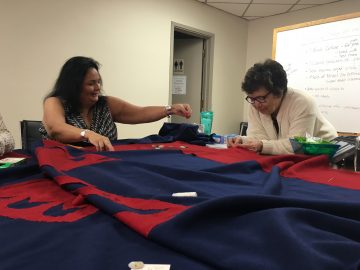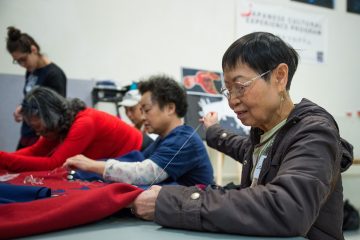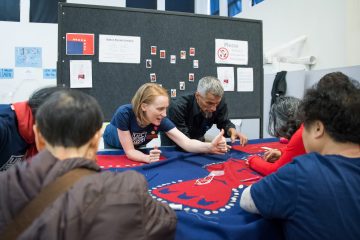Department:
Educational Studies
Project lead(s):
Dr. Alison Taylor and Matt Hume, MA
Project members:
Barbara Jenni, Catalina Bobadilla Sandoval, Emily Van Halem
Reflection:
What led you to your project/inspired your work? What values and principles guided the development of your project?
The project was inspired by a 13-minute video that was created by the UBC Learning Exchange which is located in Vancouver’s Downtown Eastside (DTES) community (see: www.learningexchange.ubc.ca). The video documents a community-university project completed with the guidance and support of Musqueam Elder Doris Fox. Elder Fox met with UBC staff, students and members from the DTES and Chinatown communities for several weeks to design, sew and complete a button blanket featuring a Thunderbird emblem. In the process of completing the button blanket, participants were encouraged not only to teach each other sewing and design techniques but also to share stories from their own lives in the hopes of promoting intercultural and intergenerational learning. The video captures the words of Elder Fox and the project participants as they reflect on the understandings and outcomes that emerged from this community-based project.
Our curriculum project involves developing pedagogical resources to be used by UBC instructors, students, and others interested in using the video as a launching point for discussion in classrooms. Working with three graduate assistants, the resources we decided to develop are:
1) a Discussion Guide;
2) Sharing our Stories Activity (facilitator guide); and
3) List of Additional Resources.
The 4 themes addressed in the Discussion Guide and Resource List are: community-engaged learning; intercultural and intergenerational learning; relationships between Indigenous and non-Indigenous peoples; and Indigenous pedagogies and knowledges.
The resources aim to reinforce the asset-based community development approach that underpins the work of the Learning Exchange in the DTES, including the ‘button blanket’ initiative. The values that underpin this initiative involve an openness to learning about others through stories and the process of co-creation. Learners in this initiative included community members in the DTES as well as UBC students working at the Learning Exchange.
The process of developing resources involved collaborative work with three graduate assistants, who did most of the work of creating the resources with guidance from the project leads. The idea of student involvement in creating resources was important, as was the involvement of Indigenous educators in reviewing resources, including Elder Fox and two educators from the Vancouver School District (an Indigenous Education Teacher and Aboriginal Enhancement Teacher).
What have you learned so far?
Barbara: I first learned about the video in a class (with Alison Tylor), and found it inspiring and informative. Having been able to contribute to the continuation of this thread was a special opportunity. Among our trio, as we referred to ourselves, we had rich exchanges and each of us brought our own perspective and previous skills to the project. Through our own sharing of stories, we explored and learned about ways to broaden the reach of the video and develop corresponding materials. The feedback from Indigenous educators on the resources list was particularly helpful to me, as I learned about additional items I had not been aware of before.
Catalina: My part in this project as a graduate assistant has encouraged me to work collaboratively, especially in a time that has felt distant from the community. The Threading our Stories video portrays an experience that has rekindled my sense of what it means to come together and learn from each other. In a similar sense, this group came together to learn and create a teaching and learning tool that can help spark conversation and reflection about necessary and outstanding Indigenous themes. As this creative and reflexive process unfolded, I learned from watching the video, conducting research, personal self-reflection, and engaging in deep conversation with colleagues. I’m hopeful that these resources will shape some important discussions in other’s learning processes.
Alison: I think the Threading Our Stories video is an excellent resource and would like to see it taken up in classes. At the same time, I’m aware that some instructors may need help in framing such discussions and in directing students toward further reading. We were also aware that instructors are likely to use resources in different ways, and therefore flexibility is important. It has been gratifying for me to see graduate students working together to approach the tasks and develop materials for other students. I have also greatly appreciated the time taken by Indigenous colleagues from the Vancouver School District to fill in gaps in our Resource List and to encourage sensitivity to how materials may be taken up.
Matt: The Threading Our Stories project grew so much from the original concept to the amazing resource it has become, and to develop this resource over Zoom to speak to a project that was itself about coming together physically in a room to share teachings and stories with one another was certainly a challenge. My biggest learning came in the amount of time and effort put forth, and the number of people who were consulted, including our team of GRAs, Elder Doris Fox and our friends at the VSB. It is such a strong reminder of how much work needs to go into a learning resource for it to even reach the piloting stage, but also so much pride in how we did it in the digital learning landscape. A huge thank you to Alison for seeing the value in the project and for everyone who supported it along the way. The task ahead now lies in finding audiences to share the project with!
Where do you plan to go? What impact/influence have you or do you see your project making?
Project Members (three graduate assistants) have completed drafts of the resources and we have sought input on the Resource List. We are now consulting with Elder Fox about the Discussion Guide. Matt is also working with a Work Learn student at the Learning Exchange to put finishing touches on the resources and then they will be made available on the Learning Exchange website.
We hope the video and accompanying resources will be used in Education classes as well as other courses across campus. Alison Tylor teaches a course, for example, in adult education that is focused on community-based adult learning (ADHE 330), where these resources would fit extremely well. In addition, the Learning Exchange hosts students from across campus, including education students in their Community Field Experience, and plans to use resources there. Finally, the Centre for Community-Engaged Learning is likely to be interested in these resources in their work with instructors across UBC.



